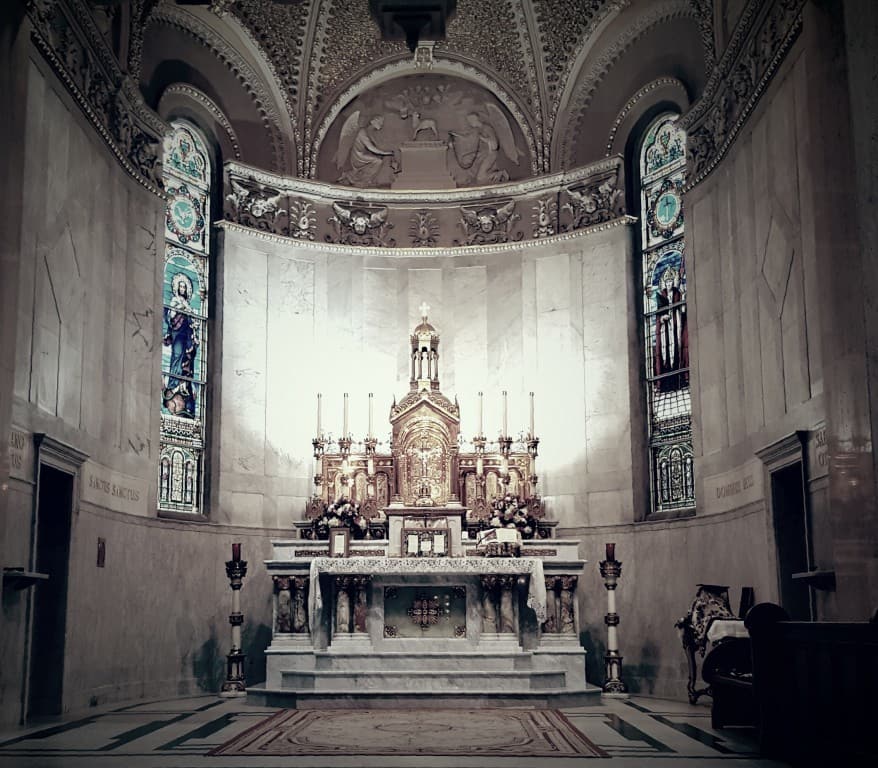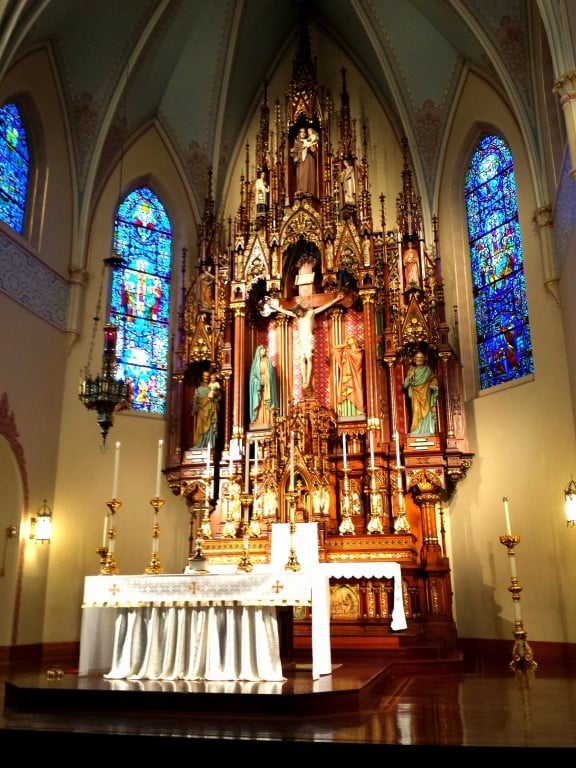The elegant beauty of most of Milwaukee’s historic Catholic churches has been captured in our gallery page. Stepping inside these sacred buildings is always a moving experience. Many were built by immigrants from Poland or Germany. These churches represent some of the city’s most impressive architectural heritage. Preservation of these local treasures should be a concern of everyone in Milwaukee. As so many popular restoration shows on television highlight, the preservation of historic homes and other buildings is the “in” thing to do. In addition to structural upkeep, a significant part of any restoration movement involves the peeling back of inconsistent and dated accretions that were added over the years. Looking back, it’s hard to believe that anyone would think concealing rich hardwood floors with green carpeting, for example, would be a good thing to do. But it was done, over and over again, in house after house. Maybe you’ve done some work in your old home and discovered something beautiful that was concealed for decades beneath layers of paint or carpeting.
Our churches too, fell victim to this trend throughout the ’60s, ’70s and up through the ’80s. The zeitgeist of those years called for more emphasis to be placed on the priest and the “community,” while less emphasis was given to the Blessed Sacrament and the sacrificial and “cosmic” dimensions of the Mass. Cardinal Robert Sarah, Prefect of the Congregation for Divine Worship and the Discipline of the Sacraments, described this shift in an interview. “In recent decades in some countries the Sacred Liturgy has become too anthropocentric; man not Almighty God has often become its focus.”
Two significant changes accommodated this shift in focus. First, the priest began to face the people, instead of the centuries-old practice of facing east with the faithful. And second, the altars themselves were moved much closer to the nave (and sometimes into the nave) to facilitate an “in-the-round” design. In many cases, the people completely surround the altar. And in some churches, the Blessed Sacrament, which should be the visible focal point in every church, has been removed from the sanctuary and into a separate chapel or off to the side somewhere. Again, man and not God becomes the focus of liturgy.
We went from a linear/vertical focus to a circular/horizontal one. Look no further than Milwaukee’s own Cathedral of Saint John the Evangelist, which underwent a “gut-rehab” in 2002. All of the incongruous architectural innovations I’ve described here are perfectly represented in the mother church of the archdiocese. The choir fills the sanctuary. Stepping inside, it’s hard not to be taken aback by the inconsistencies with the original layout of the noble building. You don’t need a degree in theology to see that the changes just don’t fit. Check out the Adoremus analysis linked above for a more extensive report on the cathedral’s renovation.
I’ve noticed this altar alteration phenomenon at other churches which underwent significant “gut-rehabs” to accommodate this “community first” approach to liturgy. It’s not just jarring from an aesthetic point of view. The theological implications are also worth discussing. This is the altar at Saint Francis parish on Milwaukee’s North Side. Notice how the new altar is almost in the middle of the nave. The original communion rail, now broken-up, props up the new table/altar. The choir occupies part of the sanctuary. Notice the piano. The Blessed Sacrament is literally in the background. Everyone faces everyone. The “self-enclosed circle” in liturgy (about which then-Cardinal Ratzinger wrote in The Spirit of the Liturgy) is on full display here. Talk about the liturgy becoming “too anthropocentric”… What happened?
Traditionally in Catholic churches, the nave was distinct and notably set apart from the sanctuary. Because of what happens there, the sanctuary is a space in the church that is especially sacred. I have to wonder, do we risk losing something valuable if we abandon visible reminders of the sacred, of that which is “set apart”? Traditional boundaries in older churches remind me that I am striving for sanctity. I’m not there yet. Sanctity, like heaven, is something I’m working toward. The nave symbolizes earth and the sanctuary, at the end of the church, represents heaven, my final goal. It is before me. The communion rail symbolizes heaven’s gate, the threshold to heaven. We lose a lot by doing away with these rich symbols in the name of egalitarianism. The Spirit of the Liturgy contains an excellent chapter on the placement of altars in our churches, and the common direction of prayer for the priest and people.
Now take a look at these altars. One is at Saint Stanislaus, designed exclusively for ad orientem worship, and the other is at Old Saint Anthony, which could accommodate ad orientem and versus populum.

 While I prefer the ad orientem altar, both altars are clearly “set apart” from the rest of the church. Even the Saint Anthony altar, which is moved out from the original high altar and reredos, retains its rightful place in the traditional sanctuary and is set apart from the nave by significant elevation and a beautiful communion rail. The original symbolism is still preserved. The focal point in both churches is where it should be: the sanctuary, housing the Blessed Sacrament, not someone sitting across from me, or the choir, or even the priest. The focus is on Christ in the Eucharist.
While I prefer the ad orientem altar, both altars are clearly “set apart” from the rest of the church. Even the Saint Anthony altar, which is moved out from the original high altar and reredos, retains its rightful place in the traditional sanctuary and is set apart from the nave by significant elevation and a beautiful communion rail. The original symbolism is still preserved. The focal point in both churches is where it should be: the sanctuary, housing the Blessed Sacrament, not someone sitting across from me, or the choir, or even the priest. The focus is on Christ in the Eucharist.
In his excellent essay on sacred architecture, Uwe Michael Lang lists several design characteristics that should be present in all Catholic churches. One of these is orientation. The in-the-round style is inconsistent with the traditional design of Catholic churches. “The ideal of the Christian church is not a circular building with the altar, ambo, and sedilia in the center; it is not mere accident that samples of this type are hardly found before the second half of the twentieth century.” Another requisite should be thresholds. Citing the General Instruction of the Roman Missal, Lang reminds readers that the sanctuary “should be appropriately marked off from the body of the church either by its being elevated or by a particular structure and ornamentation.” In light of the previously mentioned need for proper orientation within the church, it cannot be argued that an elevated sanctuary in-the-round is ideal for a sanctuary. Besides, in the case of Saint Francis and the Cathedral of Saint John the Evangelist, the original and traditional sanctuaries, were already elevated, and set apart by the “particular structure” of a Communion rail. (See “Sacred Architecture at the Service of the Mission of the Church” by Uwe Michael Lang, Sacred Liturgy: The Source and Summit of the Life and Mission of the Church, Ignatius Press, 2013)
In an era of “All are Welcome”, make-no-distinctions-inclusivity, we no longer want visible reminders of the sacred (of that which is “set apart”) because such reminders are interpreted as divisive, judgmental and exclusive. Moral distinctions are fading, so it makes sense that spacial distinctions in our churches that reflect spiritual realities would begin to lose their hold. But we need distinctions. We need reminders that we are not there yet, and that we’re striving toward our final goal.
(Read Fr. Uwe Micheal Lang’s Signs of the Holy One: Liturgy, Ritual, and Expression of the Sacred.)


